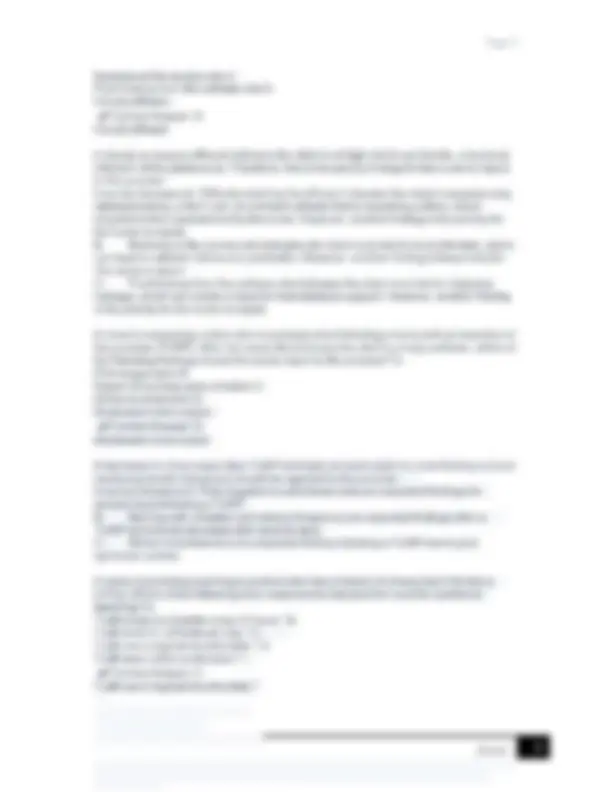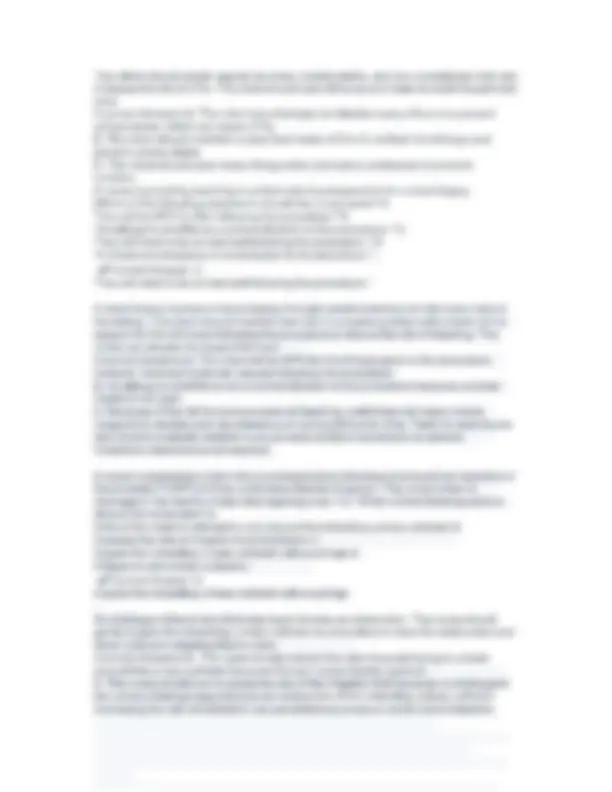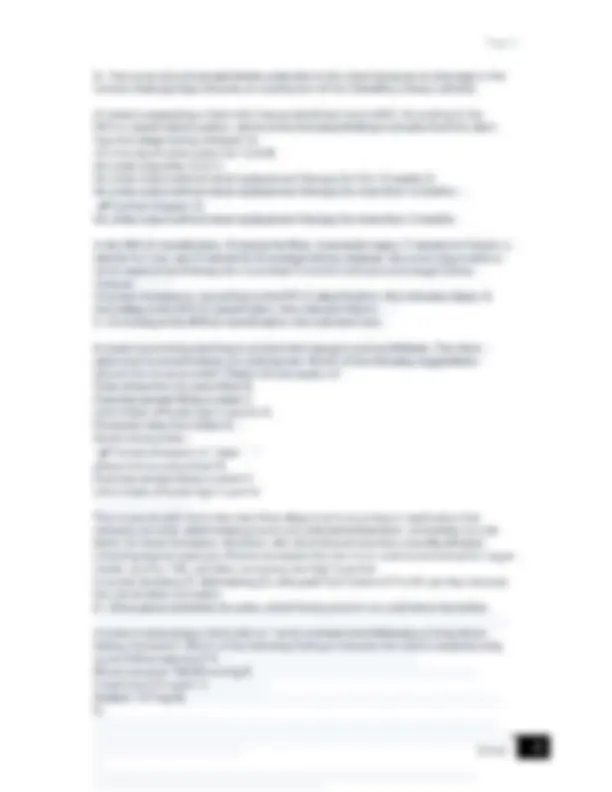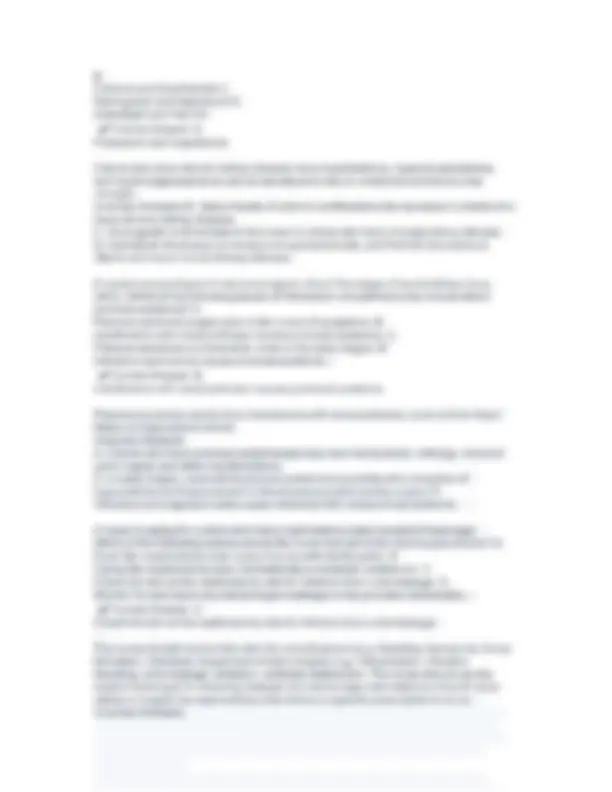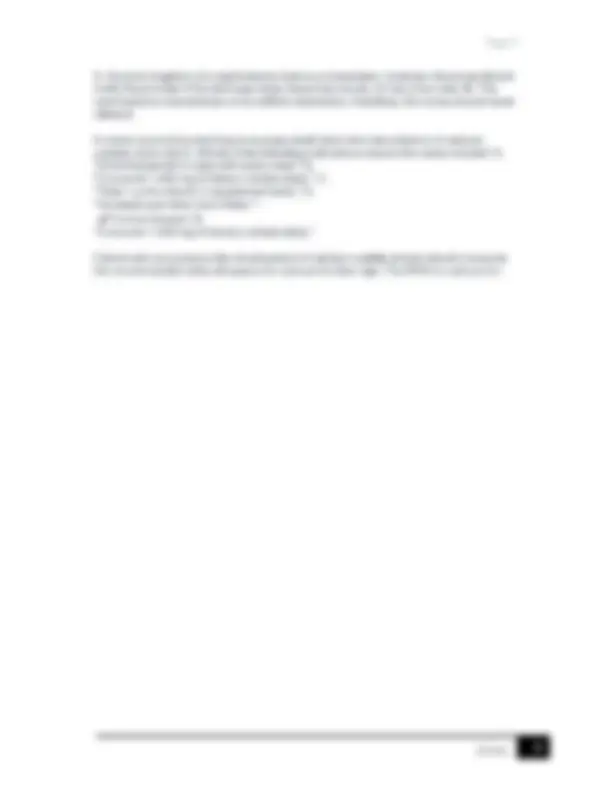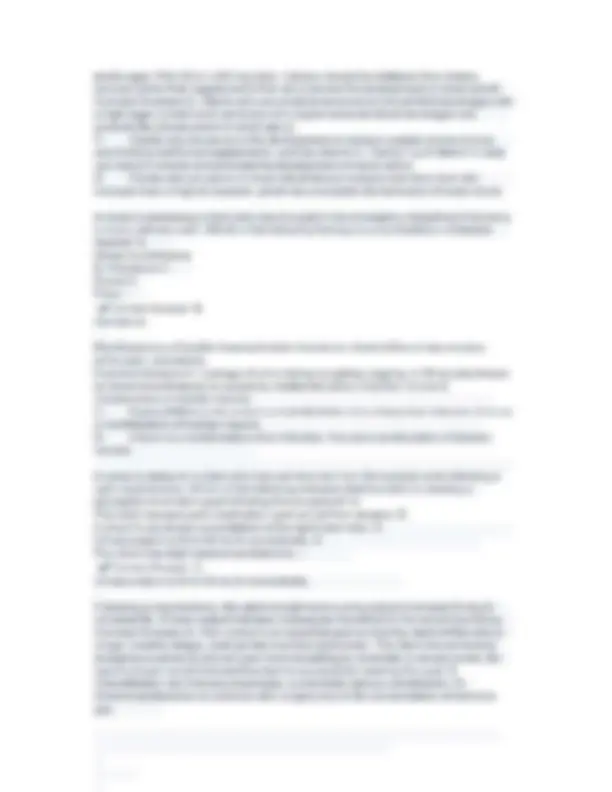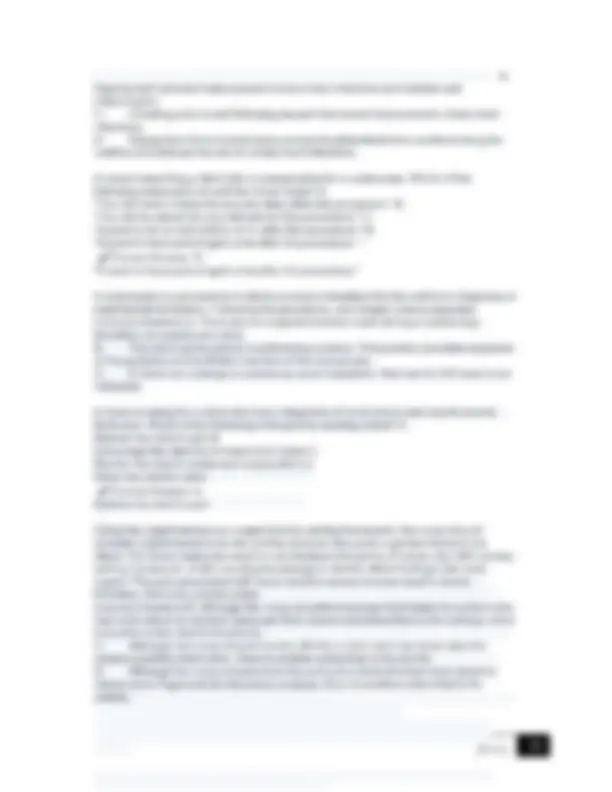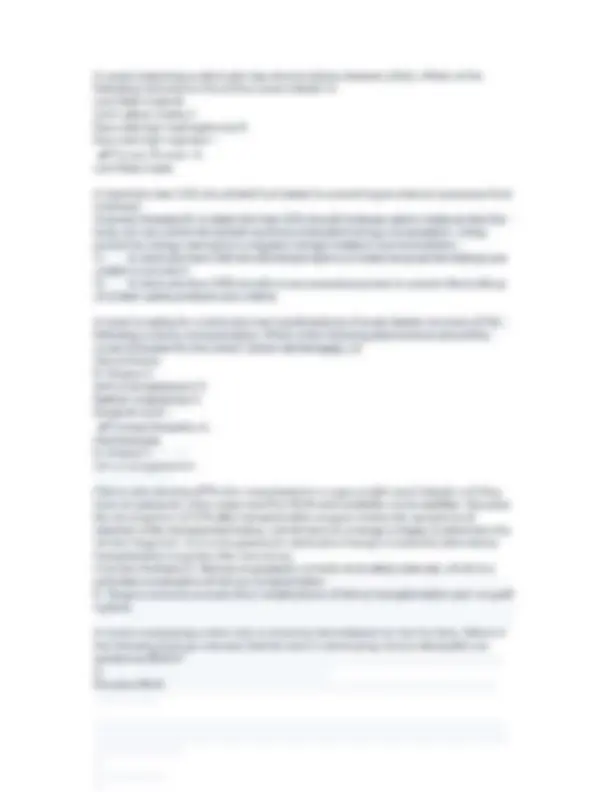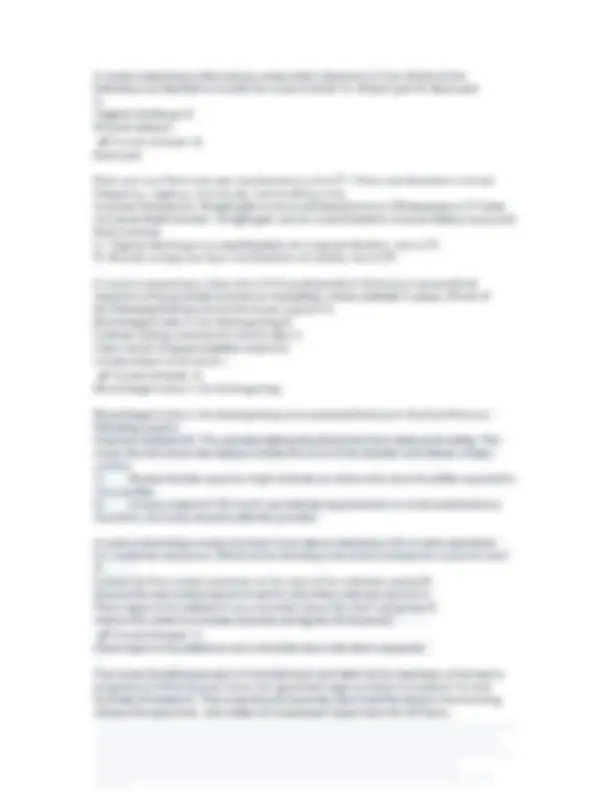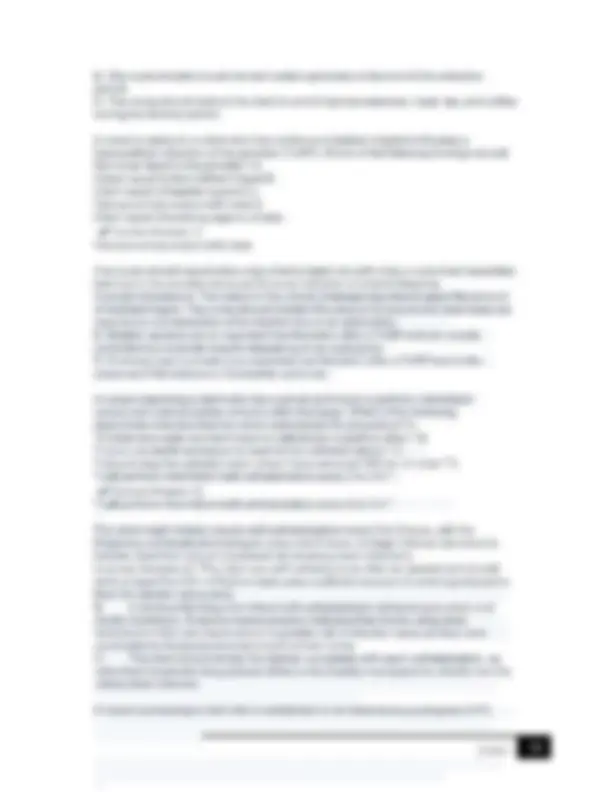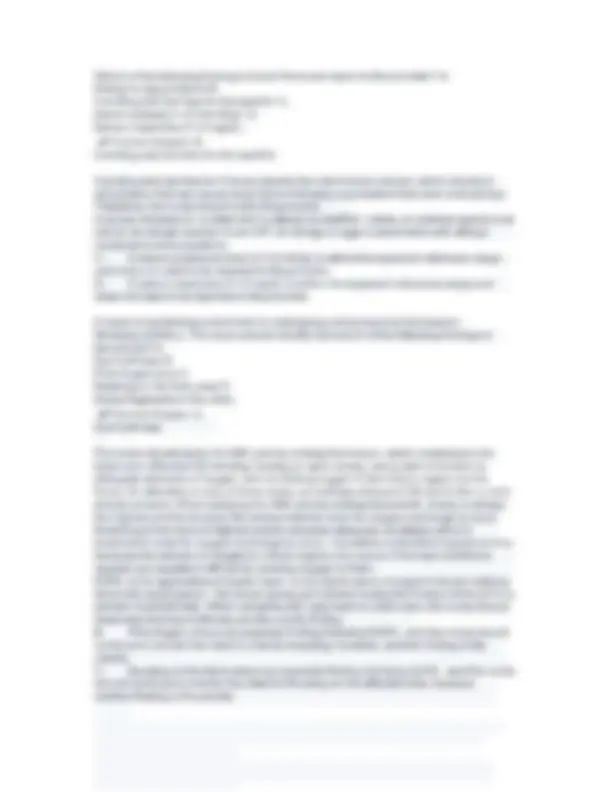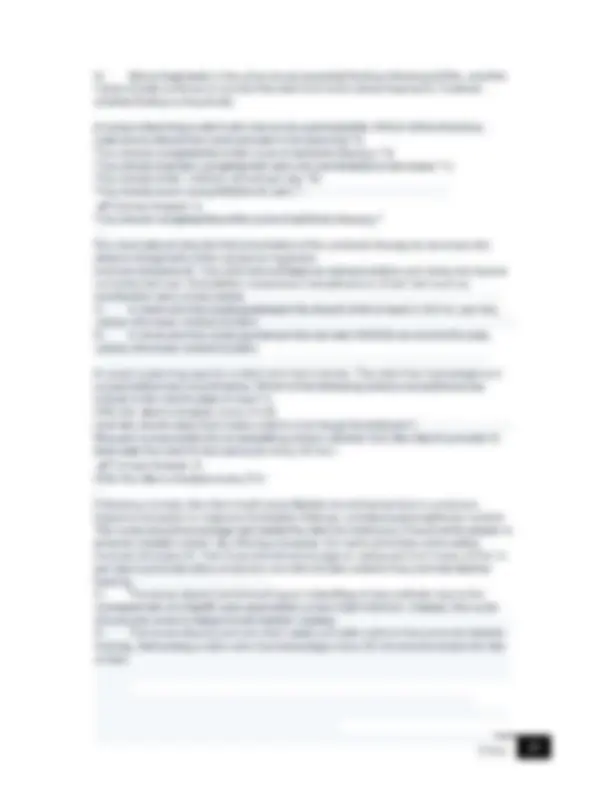Partial preview of the text
Download ATI Renal + Urinary System Practice Questions and Answers. and more Exams Laboratory Practices and Management in PDF only on Docsity!
Page 1 ATI Renal+ Urinary System Practice Questions and Answers. A nurse is caring for a client who is in the oliguric-anuric stage of acute kidney injury. The client reports diarrhea, a dull headache, palpitations, and muscle tingling and weakness. Which of the following actions should the nurse take first? A. Administer an analgesic to the client B. Check the client's electrolyte values C. Measure the client's weight D. Restrict the client's protein intake - Correct Answer: B. Check the client's electrolyte values The nurse should apply the urgent versus nonurgent priority-setting framework when caring for the client. Using this framework, the nurse should consider urgent needs to be the priority because they pose a greater threat to the client. The nurse might also need to use Maslow's hierarchy of needs, the ABC priority-setting framework, and/or nursing knowledge to identify which finding is the most urgent. The nurse should check the client's most recent potassium value because these findings are manifestations of hyperkalemia, which can lead to cardiac dysrhythmias. Incorrect Answers:A. Administering an analgesic for a dull headache is important to manage the client's pain; however, there is another action that the nurse should take first. c. Measuring the client's weight is important to monitor the client's fluid balance; however, there is another action the nurse should take first. D. Restricting the client's protein intake is important to manage the client's acute kidney injury; however, there is another action the nurse should take first. A nurse is assessing a client who has urolithiasis and reports pain in his thigh. This finding indicates the stone is in which of the following structures? A. Ureter B. Bladder Cc. Renal pelvis D. Renal tubules - Correct Answer: A. Ureter When stones are in the ureters, pain radiates to the genitalia and to the thighs. Incorrect Answers:B. Stones in the bladder produce manifestations of irritation that resemble a urinary tract infection. They can also cause pain in the vulva and scrotal areas. Cc. The renal pelvis is part of the kidney. Stones in the kidneys cause pain in the costovertebral region. D. The renal tubules are within the nephron, which is part of the kidney. Stones in the kidneys cause flank pain A nurse is reviewing the laboratory report of a client who has chronic kidney disease (CKD). The nurse finds the following laboratory test results: potassium 6.8 mEq/L, [Date] 4] calcium 7.4 mg/dL, hemoglobin 10.2 g/dL, and phosphate 4.8 mg/dL. Which finding is the priority for the nurse to report to the provider? A. Hypocalcemia B. Hyperkalemia C. Anemia D. Hypoalbuminemia - Correct Answer: B. Hyperkalemia The nurse should apply the urgent versus nonurgent priority-setting framework when caring for this client. Using this framework, the nurse should consider urgent needs the priority need because they pose more of a threat to the client. The nurse may also need to use Maslow's hierarchy of needs, the ABC priority-setting framework, and/or nursing knowledge to identify which finding is the most urgent. Hyperkalemia, which can cause life-threatening cardiac dysrhythmias, is the priority for the nurse to report to the provider. Incorrect Answers: A. Hypocalcemia is an expected finding with CKD; therefore, another finding is the priority for the nurse to report to the provider. The decreased calcium level would require reporting if the client developed muscle spasms or twitching. Cc. Anemia is an expected finding with CKD; therefore, another finding is the priority for the nurse ta report to the provider. D. Hyperphosphatemia is an expected finding with CKD; therefore, another finding is the priority for the nurse to report to the provider. A nurse is assessing a client who is receiving continuous ambulatory peritoneal dialysis. Which of the following findings should the nurse report to the provider? A. WBC 6,000/mm*3 B. Potassium 3.0 mEq/L C. Clear, pale yellow drainage D. Report of abdominal fullness - # Correct Answer: B. Potassium 3.0 mEq/L A potassium level of 3.0 mEq/L is below the expected reference range and can cause dysrhythmias. Dialysis removes fluid, waste products, and electrolytes from the blood and can cause hypokalemia. Incorrect Answers:A. AWBC count of 6,000/mm/‘3 is within the expected reference range. & Clear, pale yellow drainage is an expected finding after peritoneal dialysis has been established. BY Abdominal fullness is an expected finding during the dwell period, when the dialysate stays in the peritoneal cavity. A supine low-Fowler's position can reduce abdominal pressure. Anurse is assessing a client wha is receiving peritoneal dialysis. Which of the following findings should the nurse report to the provider immediately? A. Difficulty draining the effluent B. The client should avoid vaginal douches, bubble baths, and any substances that can increase the risk of UTIs. The client should use mild soap and water to wash the perineal area. Incorrect Answers:A. The client should empty her bladder every 4 hours to prevent urinary stasis, which can cause UTIs. B. The client should maintain a daily fluid intake of 2 to 3 L to flush the kidneys and prevent urinary stasis. D. The client should wear loose-fitting cotton (not nylon) underwear to prevent irritation. Anurse is providing teaching to a client who is preoperative for a renal biopsy. Which of the following statements should the nurse make? A. "You will be NPO for 8 hr following the procedure.” B. "An allergy to shellfish is a contraindication to this procedure." C. "You will need to be on bed rest following the procedure." D. "A creatinine clearance is needed prior to the procedure." - Correct Answer: C. "You will need to be on bed rest following the procedure." Arenal biopsy involves a tissue biopsy through needle insertion into the lower lobe of the kidney. The client should maintain bed rest in a supine position with a back roll for support for 2 to 24 hours following the procedure to reduce the risk of bleeding. The nurse can elevate the head of the bed. Incorrect Answers:A. The client will be NPO for 4 to 8 hours prior to the procedure; however, food and fluids can resume following the procedure. B. Anallergy to shellfish is not a contraindication to this procedure because contrast media is not used. D. Because of the risk for post-procedural bleeding, preliminary lab tests include coagulation studies such as platelet count and prothrombin time. Tests for anemia are also done to evaluate whether a pre-procedural blood transfusion is needed. Creatinine clearance is not required. Anurse is assessing a client who is postoperative following a transurethral resection of the prostate (TURP) and has continuous bladder irrigation. The nurse notes no drainage in the client's urinary drainage bag over 1 hr. Which of the following actions should the nurse take? A. Instruct the client to attempt to void around the indwelling urinary catheter B. Increase the rate of irrigation fluid instillation C. Irrigate the indwelling urinary catheter with a syringe D. Prepare to administer a diuretic - Correct Answer: C. Irrigate the indwelling urinary catheter with a syringe No drainage in the urinary drainage bag indicates an obstruction. The nurse should gently irrigate the indwelling urinary catheter as prescribed to clear the obstruction and allow urine and irrigating fluid to drain. Incorrect Answers:A. The nurse should instruct the client to avoid trying to urinate around the urinary catheter because this can cause bladder spasms. B. The nurse should not increase the rate of the irrigation fluid because no drainage in the urinary drainage bag indicates an obstruction of the indwelling urinary catheter. Increasing the rate of instillation can put additional pressure on the client's bladder. Page 5 D. The nurse should not administer a diuretic to the client because no drainage in the urinary drainage bag indicates an obstruction of the indwelling urinary catheter. Anurse is assessing a client who has acute kidney injury (AKI). According to the RIFLE classification system, which of the following findings indicates that the client has end-stage kidney disease? A. <0.5 mL/kg of urine output for 12 hr B. No urine output for 12 hr C. No urine output without renal replacement therapy for 4 to 12 weeks D. No urine output without renal replacement therapy for more than 3 months - Correct Answer: D. No urine output without renal replacement therapy for more than 3 months In the RIFLE classification, R stands for Risk, | stands for Injury, F stands for Failure, L stands for Loss, and E stands for End-stage kidney disease. No urine output without renal replacement therapy for more than 3 months indicates end-stage kidney disease. Incorrect Answers:A. According to the RIFLE classification, this indicates injury. B. According to the RIFLE classification, this indicates failure. C. According to the RIFLE classification, this indicates loss. Anurse is providing teaching to a client who has gout and urolithiasis. The client asks how to prevent future uric acid stones. Which of the following suggestions should the nurse provide? (Select all that apply.) A. Take allopurinol as prescribed B. Exercise several times a week C. Limit intake of foods high in purine D. Decrease daily fluid intake E. Avoid citrus juices - Correct Answers: A. Take allopurinol as prescribed B. Exercise several times a week C. Limit intake of foods high in purine The nurse should inform the client that allopurinol is an antigout medication that reduces uric acid, which helps prevent uric acid stone formation. Immobility is a risk factor for stone formation; therefore, the client should maintain a healthy lifestyle, including regular exercise. Purine increases the risk of uric acid stone formation; organ meats, poultry, fish, red wine, and gravy are high in purine. Incorrect Answers:D. Maintaining an adequate fluid intake of 2 to 3 L per day reduces the risk of stone formation. E. Citrus juices alkalinize the urine, which helps prevent uric acid stone formation. Anurse is assessing a client who is 1 week postoperative following a living donor kidney transplant. Which of the following findings indicates the client is experiencing acute kidney rejection? A. Blood pressure 160/90 mmHg B. Creatinine 0.8 mg/dL C. Sodium 137 mg/dL Dy [Date] Is Page 7 After a TURP, the client will feel the urge to urinate. The nurse should reassure him that he will receive analgesics to help relieve this discomfort. Incorrect Answers:A. The client will require an indwelling urinary catheter following a TURP to monitor urine output and bleeding. B. Cloudy urine can be a manifestation of retrograde ejaculation or infection. The client should report cloudy urine to the provider. Cc. The client might have temporary dribbling and leakage of urine following a TURP. The nurse should reassure the client that these manifestations will resolve. A nurse is providing dietary teaching a client who has late-stage chronic kidney disease (CKD). Which of the following nutrients should the nurse instruct the client to increase in her diet? A. Calcium B. Phosphorous C. Potassium D. Sodium - Correct Answer: A. Calcium A client who has CKD can develop hypocalcemia due to the reduced production of active vitamin D, which is needed for calcium absorption. The client should supplement dietary calcium. Incorrect Answers:B. A client who has CKD can develop hyperphosphatemia because excretion of phosphorous by the kidneys is reduced. €. Aclient who has CKD can develop hyperkalemia because excretion of potassium by the kidneys is reduced. D. Aclient who has CKD can develop hypernatremia because excretion of sodium by the kidneys is reduced. Anurse is caring for a client who is receiving peritoneal dialysis. The nurse notes that the client's dialysate output is less than the input and that his abdomen is distended. Which of the following actions should the nurse take? A. Insert an indwelling urinary catheter B. Administer pain medication to the client C. Change the client's position D. Place the drainage bag above the client's abdomen - Correct Answer: C. Change the client's position This client is retaining the dialysate solution after the dwell time. The nurse should ensure that the clamp is open and the tubing is not kinked and should reposition the client to facilitate the drainage of the solution from the peritoneal cavity. Incorrect Answers:A. Peritoneal dialysis is used for clients who have acute or chronic kidney disease. An indwelling urinary catheter will not relieve the client's discomfort. B. The client is retaining the dialysate solution after the dwell time. Pain medication will not correct the cause of the client's discomfort. D. The nurse should position the drainage bag lower than the client's abdomen to promote gravity drainage. Anurse is checking the laboratory values of a client who has chronic kidney disease. The nurse should expect elevations in which of the following values? A. Potassium and magnesium [Date] | 7] B. Calcium and bicarbonate C. Hemoglobin and hematocrit D. Arterial pH and PaCO2 - Correct Answer: A. Potassium and magnesium Clients who have chronic kidney disease have hyperkalemia, hyperphosphatemia, and hypermagnesemia as well as elevations in serum creatinine and blood urea nitrogen. Incorrect Answers:B. Serum levels of calcium and bicarbonate decrease in clients who have chronic kidney disease. C. Hemoglobin and hematocrit decrease in clients who have chronic kidney disease. D. Arterial pH decreases or remains at expected levels, and PaCO2 decreases in clients who have chronic kidney disease. A nurse is preparing an in-service program about the stages of acute kidney injury (AKI). Which of the following pieces of information should the nurse include about prerenal azotemia? A. Prerenal azotemia begins prior to the onset of symptoms. B. Interference with renal perfusion causes prerenal azotemia. C. Prerenal azotemia is irreversible, even in the early stages. D. Infections and tumors cause prerenal azotemia. - Correct Answer: B. Interference with renal perfusion causes prerenal azotemia. Prerenal azotemia results from interference with renal perfusion, such as from heart failure or hypovolemic shock. Incorrect Answers: A. Clients who have prerenal azotemia typically have tachycardia, lethargy, reduced urine output, and other manifestations. C. In early stages, reversal of prerenal azotemia is possible with correction of hypovolemia and improvement in blood pressure and cardiac output. D. Infections and ingested toxins cause intrarenal AKI, not prerenal azotemia. Anurse is caring for a client who had a nephrostomy tube inserted 8 hours ago. Which of the following actions should the nurse include in the client's plan of care? A. Flush the nephrostomy tube every 4 hours with sterile water. B. Clamp the nephrostomy tube intermittently to establish continence. C. Check the skin at the nephrostomy site for irritation from urine leakage. D. Monitor for and report any blood-tinged drainage to the provider immediately. - Correct Answer: C. Check the skin at the nephrostomy site for irritation from urine leakage. The nurse should monitor the client for complications (e.g. bleeding, hematuria, fistula formation, infection), impairment of skin integrity (e.g. inflammation, infection, bleeding, urine leakage, irritation), and tube obstruction. The nurse should use the aseptic technique for dressing changes and encourage oral intake but should never clamp or irrigate the nephrostomy tube without a specific prescription to do so. Incorrect Answers: adults ages 19 to 50 is 1,000 mg daily. Calcium should be obtained from dietary sources rather than supplements that can promote the development of renal calculi. Incorrect Answers:A. Clients who are prone to renal calculi should limit beverages with a high sugar content such as fruit punch or juice because these beverages can promote the development of renal calculi. Cc. Clients who are prone to the development of calcium oxalate stones should avoid taking nutritional supplements, such as vitamin C. Taking 1 g of vitamin C daily can result in toxicity and promote the development of renal calculi. De Clients who are prone to renal calculi should exclude bran from their diet because bran is high in oxalates, which can precipitate the formation of renal calculi. A nurse is assessing a client who was brought to the emergency department following a motor-vehicle crash. Which of the following findings is a manifestation of bladder trauma? A. Stress incontinence B. Hematuria C. Pyuria D. Fever - Correct Answer: B. Hematuria Manifestations of bladder trauma include hematuria, blood at the urinary meatus, pelvic pain, and anuria. Incorrect Answers:A. Leakage of urine during coughing, jogging, or lifting (also known as stress incontinence) is caused by weakened pelvic muscles. It is not a manifestation of bladder trauma. Cc. Pyuria (WBGs in the urine) is a manifestation of a urinary tract infection. It is not a manifestation of bladder trauma. D. A fever is a manifestation of an infection. It is not a manifestation of bladder trauma. Anurse is caring for a client who has just returned from the surgical suite following a right nephrectomy. Which of the following indicates that the client is meeting a successful short-term goal following this procedure? A. The client requests pain medication upon arrival from surgery. B. Achest X-ray shows consolidation in the right lower lobe. C. Urinary output is 35 to 50 mL/hr consistently. D. The client has slight abdominal distention. - Correct Answer: C. Urinary output is 35 to 50 mL/hr consistently. Following a nephrectomy, the client should have a urine output of at least 30 mL/hr consistently. A lower output indicates inadequate blood flow to the remaining kidney. Incorrect Answers:A. Pain control is an essential goal so that the client will be able to cough, breathe deeply, and use the incentive spirometer. The client should receive analgesia routinely to prevent pain from escalating to moderate or severe levels. No reports of pain would indicate the client is successfully meeting this goal. B. Consolidation can indicate pneumonia, a potentially serious complication. D. Abdominal distention is common after surgery due to the accumulation of intestinal gas. Anurse is caring for a client who is receiving peritoneal dialysis. The nurse should monitor the client for which of the following adverse effects? A. Diarrhea B. Increased serum albumin C. Hypoglycemia D. Peritonitis - Correct Answer: D. Peritonitis Peritonitis is an adverse effect of peritoneal dialysis. Prevention requires using sterile technique and frequently assessing the catheter exit site. The nurse should obtain cultures of the dialysate outflow (effluent) if peritonitis is suspected. Incorrect Answers:A. Diarrhea is not an adverse effect of peritoneal dialysis. The nurse should instruct the client to increase fiber intake to prevent constipation, which can reduce dialysate flow. B. Decreased serum albumin is an adverse effect of peritoneal dialysis. Protein can be lost through the dialysis exchange, resulting in protein wasting. A decreased serum albumin level is a manifestation of protein wasting. Cc. Hyperglycemia is an adverse effect that can occur in clients who have diabetes mellitus and clients who absorb glucose from the dialysate. Anurse is caring for a client who has chronic glomerulonephritis with oliguria. For which of the following electrolyte imbalances should the nurse monitor? A. Hypercalcemia B. Hyperkalemia C. Hypomagnesemia Hypophosphatemia - Correct Answer: B. Hyperkalemia Oliguria resulting from chronic glomerulonephritis causes potassium retention, leading to levels above the expected reference range of 3.5 to 5 mEq/L. Other electrolyte imbalances common with this disorder affect sodium and phosphorus levels. Chronic glomerulonephritis eventually leads to end-stage kidney disease. Incorrect Answers:A. The nurse should expect a client who has chronic glomerulonephritis with oliguria to have a calcium level at the lower end of or slightly below the expected reference range of 9 to 10.5 mg/dL. c. The nurse should expect a client who has chronic glomerulonephritis with oliguria to have a magnesium level within the expected reference range of 1.3 to 2.1 mEq/L. The major electrolyte imbalances common with this disorder affect potassium, sodium, and phosphorus levels. D. The nurse should expect a client who has chronic glomerulonephritis with oliguria to have a phosphorous level above the expected reference range of 3 to 4.5 mg/dL. A nurse is conducting dietary teaching with a client who has a history of renal calculi. Which of the following instructions should the nurse include in the teaching? A. Consume foods containing vitamin C B. Drink 3.8 L (4 qt) of water throughout the day C. [Date] Staying well hydrated helps prevent urinary tract infections and bladder wall inflammation. c. Urinating prior to and following sexual intercourse helps prevent urinary tract infections. D. Wiping from front to back helps prevent fecal bacteria from contaminating the urethra and reduces the risk of urinary tract infections. Anurse is teaching a client who is preoperative for a cystoscopy. Which of the following statements should the nurse make? A. "You will need to keep the sutures clean after this procedure." B. "You will be placed on your left side for this procedure." C. "Expect to be on bed rest for 24 hr after this procedure." D. “Expect to have pink-tinged urine after this procedure." - Correct Answer: D. "Expect to have pink-tinged urine after this procedure." A cystoscopy is a procedure in which a scope is inserted into the urethra to diagnose or treat bladder problems. Following the procedure, pink-tinged urine is expected. Incorrect Answers:A. There are no surgical incisions made during a cystoscopy; therefore, no sutures are used. Be The client will be placed in a lithotomy position. This position provides exposure of the genitalia and facilitates insertion of the cystoscope. c. Aclient can undergo a cystoscopy as an outpatient. Bed rest for 24 hours is not indicated. Anurse is caring for a client who has a diagnosis of renal calculi and reports severe flank pain. Which of the following is the priority nursing action? A. Relieve the client's pain B. Encourage the client to increase fluid intake C. Monitor the client's intake and output (I&O) D. Strain the client's urine - Correct Answer: A. Relieve the client's pain Using the urgent versus non-urgent priority-setting framework, the nurse should consider urgent needs to be the priority because they pose a greater threat ta the client. The nurse might also need to use Maslow’s hierarchy of needs, the ABC priority- setting framework, and/or nursing knowledge to identify which finding is the most urgent. The pain associated with renal calculi is severe and can lead to shock; therefore, this is the priority action. Incorrect Answers:B. Although the nurse should encourage fluid intake for a client who has renal calculi to maintain adequate fluid volume and blood flow to the kidneys, there is another action that is the priority. fo Although the nurse should monitor 1&0 for a client who has renal calculi to assess possible obstruction, there is another action that is the priority. D. Although the nurse should strain the urine of a client who has renal calculi ta obtain stone fragments for laboratory analysis, there is another action that is the priority. ove Anurse is teaching a client who has chronic kidney disease (CKD). Which of the following instructions should the nurse include? A. Limit fluid intake B. Limit caloric intake C. Eat a diet high in phosphorus D. Eat a diet high in protein - Correct Answer: A. Limit fluid intake A client who has CKD should limit fluid intake to prevent hypervolemia (excessive fluid overload). Incorrect Answers:B. A client who has CKD should increase caloric intake so that the body can use protein for protein synthesis instead of energy consumption. Using protein for energy can lead to a negative nitrogen balance and malnutrition. Cc. Aclient who has CKD should limit phosphorus intake because the kidneys are unable to excrete it. D. Aclient who has CKD should not eat excessive protein to prevent the build-up of protein waste products and uremia. Anurse is caring for a client who has manifestations of acute tubular necrosis (ATN) following a kidney transplantation. Which of the following interventions should the nurse anticipate for this client? (Select all that apply.) A. Hemodialysis B. Biopsy C. Immunosuppression D. Balloon angioplasty E. Surgical repair - Correct Answers: A. Hemodialysis B. Biopsy C. Immunosuppression Clients who develop ATN after transplantation surgery might need dialysis until they have an adequate urine output and their BUN and creatinine levels stabilize. Because the development of ATN after transplantation surgery mimics the symptoms of rejection of the transplanted kidney, clients have to undergo a biopsy to determine the correct diagnosis. Immunosuppressive medication therapy is essential after kidney transplantation to protect the new kidney. Incorrect Answers:D. Balloon angioplasty corrects renal artery stenosis, which is a potential complication of kidney transplantation. E. Surgery corrects several other complications of kidney transplantation such as graft rupture. Anurse is assessing a client who is receiving hemodialysis for the first time. Which of the following findings indicates that the client is developing dialysis disequilibrium syndrome (DDS)? A. Elevated BUN Correct Answer: C. Headache DDS is a CNS disorder that can develop in clients who are new to dialysis due to the rapid removal of solutes and changes in the blood pH. Clients beginning hemodialysis are at greatest risk, particularly if their BUN is above 175. DDS causes headaches, nausea, vomiting, a decreased level of consciousness, seizures, and restlessness. When the condition is severe, clients progress to confusion, seizures, coma, and death. Incorrect Answers: A. An elevated BUN increases the client's risk of developing DDS; however, it is not a manifestation of this complication. B. Aloss of body fluid activates the body's compensatory mechanisms. In this case, the rapid decrease in fluid volume after dialysis causes the heart to try to compensate by increasing the heart rate. Therefore, the client would have tachycardia, not bradycardia. D. An elevated temperature indicates a possible infection, which is a common risk for clients undergoing dialysis, not DDS. Anurse is caring for a client who is receiving intermittent peritoneal dialysis. The nurse observes that the peritoneal fluid is not adequately draining. Which of the following actions should the nurse take? A. Turn the client from side to side B. Elevate the height of the dialysate bag C. Lower the head of the client's bed D. Advance the catheter approximately 2.5 cm (1 in) further - Correct Answer: A. Turn the client from side to side The nurse should assist the client in turning from side to side to facilitate the removal of peritoneal drainage. This action helps ensure there are no kinks in the tubing or an air lock in the peritoneal catheter. Incorrect Answers:B. The nurse should raise the height of the dialysate bag to increase the rate of inflow; however, this action will not promote outflow of peritoneal fluid. Cc. The nurse should elevate the head of the client's bed to promote outflow of the peritoneal fluid. De The nurse should not push the peritoneal catheter further into the peritoneal cavity because this action introduces bacteria into the peritoneal cavity and increases the client's risk of peritonitis. Anurse is teaching a newly licensed nurse about caring for a client who has a new left arteriovenous fistula. Which of the following statements should the nurse make? A. "Check the fistula site daily for a vibration." B. "Instruct the client to restrict movement of his left arm." Cc. “Avoid taking a blood pressure on the client's left arm." D. "Instruct the client to sleep on his left side." - Correct Answer: C. "Avoid taking a blood pressure on the client's left arm." The nurse should avoid taking blood pressure measurements on the client's left arm, as this can decrease blood flow and cause clotting. Incorrect Answers:A. The nurse should assess the client every 4 hours for blood flow. B. The client should perform range-of-motion exercises of the left arm. D. Sleeping on top of the extremity with the access site can impair blood flow and cause possible clotting. A nurse is providing dietary teaching to a client who has chronic renal failure. Which of the following food choices by the client indicates an understanding of the teaching? A. Canned soup B. Grilled fish C. Pastrami D. Peanut butter - Correct Answer: B. Grilled fish Protein choices, such as fresh fish or poultry, can minimize the risk of worsening chronic renal failure. Incorrect Answers:A. Foods that are high in sodium, such as canned soup, should be avoided by clients who have chronic renal failure. Cc. Foods that are high in sodium, such as pastrami, should be avoided by clients who have chronic renal failure. D. Foods that are high in sodium, such as peanut butter, should be avoided by clients who have chronic renal failure. A nurse is teaching a client with chronic kidney disease about predialysis dietary recommendations. The nurse should recommending restricting the intake of which of the following nutrients? A. Protein B. Carbohydrates C. Calcium D. Monounsaturated fats - + Correct Answer: A. Protein Dietary restrictions for clients who have chronic kidney disease vary based on the degree of kidney function; however, most clients need protein limitations. Predialysis protein restriction can help preserve some kidney function. Incorrect Answers:B. Clients who have chronic kidney disease require enough calories to avoid the use of muscle protein for energy. Carbohydrates are a good source of calories for these clients. Cc. Many clients who have chronic kidney disease require calcium, vitamin D, and iron supplements. DB: Clients who have chronic kidney disease require enough calories to avoid the use of muscle protein for energy. Foods like canola oil and olive oil are monounsaturated fats that can supply additional calories in the client's meals. [Date] B. The nurse should include the last voided specimen at the end of the collection period. D. The nurse should instruct the client to avoid vigorous exercise, meat, tea, and coffee during the 24-hour period. Anurse is caring for a client who has continuous bladder irrigation following a transurethral resection of the prostate (TURP). Which of the following findings should the nurse report to the provider? A. Output equal to the instilled irrigant B. Client report of bladder spasms C. Viscous urinary output with clots D. Client report of a strong urge to urinate - Correct Answer: C. Viscous urinary output with clots The nurse should report urine output that is bright red with clots or urine that resembles ketchup to the provider because this is an indication of arterial bleeding. Incorrect Answers:A. The output in the urinary drainage bag should equal the amount of instilled irrigant. The nurse should monitor this amount to ensure the client does not experience overdistention of the bladder due to an obstruction. B. Bladder spasms are an expected manifestation after a TURP and are usually controlled by a smooth muscle relaxant such as oxybutynin. D. Astrong urge to urinate is an expected manifestation after a TURP due to the pressure of the balloon on the bladder sphincter. A nurse is teaching a client who has a spinal cord injury to perform intermittent urinary self-catheterization at home after discharge. Which of the following statements indicates that the client understands the procedure? A. "I'll drink less water so | don't have to catheterize myself too often." B. "| must use sterile technique for each of the catheterizations." C. "| should stop the catheterization when | have removed 150 mL of urine.” D. "| will perform intermittent self-catheterization every 2 to 3 hr." - Correct Answer: D. "IL will perform intermittent self-catheterization every 2 to 3 hr." The client might initially require self-catheterization every 2 to 3 hours, with the frequency eventually increasing to every 4 to 6 hours. A longer interval can result in bladder distention and an increased risk of urinary tract infections. Incorrect Answers:A. The client can self-catheterize as often as needed and should drink at least 2 to 2.5 L of fluid to make sure a sufficient amount of urine is produced to flush the bladder adequately. Be A client performing intermittent self-catheterization at home uses clean (not sterile) technique. Evidence-based practice indicates that clients using clean technique in their own home are at no greater risk of infection because they have acclimated to the bacterial environment of their home. Cc. The client should empty the bladder completely with each catheterization, as urine that remains for lang periods of time in the bladder increases the client's risk of a urinary tract infection. A nurse is preparing a client who is scheduled for an intravenous pyelogram (IVP). [Date] | 19 | Which of the following findings should the nurse report to the provider? A. Allergy to egg products B. Vomiting and diarrhea for the last 6 hr C. Serum potassium of 3.6 mEq/L D. Serum creatinine of 1.2 mg/dL - Correct Answer: B. Vomiting and diarrhea for the last 6 hr Vomiting and diarrhea for 6 hours deplete the client's fluid volume, which results in dehydration that can cause renal failure following a procedure that uses contrast dye. Therefore, the nurse should notify the provider. Incorrect Answers:A. A client who is allergic to shellfish, iodine, or contrast agents is at risk for an allergic reaction to an IVP. An allergy to eggs is associated with allergic reactions to immunizations. Cc. Aserum potassium level of 3.6 mEq/L is within the expected reference range and does not need to be reported to the provider. D. Aserum creatinine of 1.2 mg/dL is within the expected reference range and does not need to be reported to the provider. Anurse is monitoring a client who is undergoing extracorporeal shockwave lithotripsy (ESWL). The nurse should identify that which of the following findings is the priority? A. Dysrhythmias B. Pink-tinged urine C. Bruising on the flank area D. Stone fragments in the urine - Correct Answer: A. Dysrhythmias The nurse should apply the ABC priority-setting framework, which emphasizes the basic core of human functioning: having an open airway, being able to breathe in adequate amounts of oxygen, and circulating oxygen to the body's organs via the blood. An alteration in any of these areas can indicate a threat to life and is the nurse's priority concern. When applying the ABC priority-setting framework, airway is always the highest priority because the airway must be clear for oxygen exchange to occur. Breathing is the second-highest priority because adequate ventilatory effort is essential in order for oxygen exchange to occur. Circulation is the third-highest priority because the delivery of oxygen to critical organs only occurs if the heart and blood vessels are capable of efficiently carrying oxygen to them. ESWL is the application of sound, laser, or dry shock wave energies to break a kidney stone into small pieces. The shock waves are initiated during the R wave of the ECG to prevent dysrhythmias. When using the ABC approach to client care, the nurse should determine that dysrhythmias are the priority finding. B. Pink-tinged urine is an expected finding following ESWL, and the nurse should continue to monitor the client's urine for bleeding; however, another finding is the priority. Cc. Bruising on the flank area is an expected finding following ESWL, and the nurse should continue to monitor the client for bruising on the affected side; however, another finding is the priority. 
